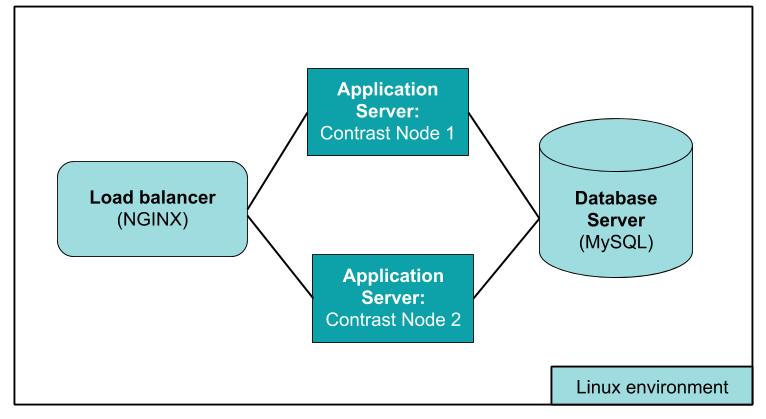Distributed deployment of Contrast
A distributed configuration of Contrast deploys the database and application server to separate servers. This is a good choice if you:
Use more than 100 connected agents
Want to improve load-balancing for better performance and scalability
Require additional administration and management
Here is an example configuration using four servers: a load-balancer, a database server and two application servers running Contrast. (You can add more nodes using the same method.)

Note
This example assumes you will install Contrast in a Linux environment at /usr/local/contrast. However, your organization may use different environments or have different guidelines on where to install third-party software.
Prerequisites
If you are already using Contrast, use your existing instance as Application Server 1 and be sure it uses a distributed database configuration. Before you continue, you should:
If you don't already have one, create a distributed MySQL environment.
Get Contrast application version numbers by looking in the VERSION file at /usr/local/contrast/VERSION. Get the Contrast database version using this command:
select `version` from schema_version ORDER BY `installed_on` DESC LIMIT 1;
Tip
You will need this version to determine the order of tasks.
For example, if the application version is 3.3.2 and the database is version 3.3.2.012, you can say the versions are the same because it's safe to drop .012 from the database version number. Because of this, an existing application server A can run with a separate database B on version 3.3.2. If you want to install application version 3.4.2 onto a new application server C and connect it to database B, you will need to either stop or update server A before installing version 3.4.2 on server C.
If you are new to Contrast, you should:
Install and configure MySQL on the database server according to Contrast system requirements. Create a MySQL user who has permissions to connect remotely. You will use these credentials to connect to Contrast.
Install Contrast on Application Server 1 with a distributed database configuration.
Select the option for a distributed MySQL instance. Point the database creation to the database server, for example:
Choose a MySQL database configuration. Default [1, Enter], Distributed [2]2 Host [localhost] <enter hostname of Mysql server> Port [13306] 3306 Credentials Username contrast Password <enter mysql password for contrast account>
When installation is complete, Contrast begins an initial configuration. It can take two to three minutes to fully start up.
To check configuration progress, watch
server.logandcontrast.log. When the server successfully starts, you will see something like this inserver.log:260916 20.18.25,837 {} {} {} INFO (Server.java:303) Contrast TeamServer Ready - Took 119305ms
Set up additional servers
Create a TAR from the Application Server 1's configuration files:
data/conf/
data/esapi/
data/.contrast
data/.initialized
data/contrast.lic
VERSION
Tip
These Linux commands will compress configuration files as a TAR into your user's home directory, for example:
$ cd /usr/local/contrast $ tar -czvf ~/ctdc.tar.gz data/conf data/contrast.lic data/esapi/ data/.initialized data/.contrast VERSION
Install Contrast on Application Server 2.
Important
Complete the run process as a privileged user. On Windows, right-click on the installer and select Run as administrator. On Linux, use the
sudocommand to launch the installer.Full or Application Only Install Choose the desired installation type: Full install [1, Enter], Application Server Only [2] 2
Select Application Server Only and use the TAR file you created in the previous step. Do the same for any additional application servers you want to add to the distributed configuration.
Test the default users created by the application to be sure they work with both Contrast Application Servers (1 and 2).
Set up a load balancer (like NGINX) on the fourth server. If you choose NGINX, use the basic installation instructions.
Note
Contrast requires sticky or persistent sessions for better performance. For example, with an NGINX load balancer, use the Ip Hash method to guarantee that requests from the same address get to the same server if it’s available.
Once you set up the server, you must configure Contrast to point to your load balancer. To do this, edit the /data/conf/general.properties file on each node. Change the teamserver.url value in the YAML config file, to that of the load balancer and restart the Contrast application server.
Important
Agents use the Contrast URL to communicate back to the application. Contrast attempts to determine the hostname and pre-populate this value. If clients on the network can't resolve the hostname you provide, they won't communicate back to the server. Please set this value to a Contrast host or load balancer that the agent hosts can reach.